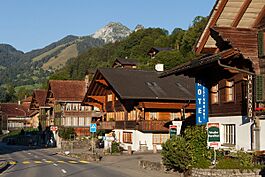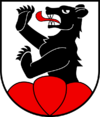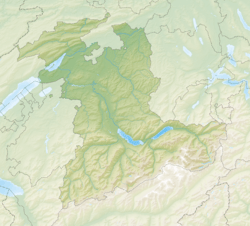Boltigen facts for kids
Quick facts for kids
Boltigen
|
||
|---|---|---|

Boltigen village
|
||
|
||
| Country | Switzerland | |
| Canton | Bern | |
| District | Obersimmental-Saanen | |
| Area | ||
| • Total | 77.07 km2 (29.76 sq mi) | |
| Elevation | 814 m (2,671 ft) | |
| Population
(Dec 2020 )
|
||
| • Total | 1,249 | |
| • Density | 16.206/km2 (41.973/sq mi) | |
| Postal code |
3766
|
|
| Surrounded by | Diemtigen, Jaun (FR), Oberwil im Simmental, Plaffeien (FR), Saanen, Zweisimmen | |
Boltigen is a small town in the canton of Bern in Switzerland. It's located in the Obersimmental-Saanen administrative district.
Boltigen is a mix of a burgess community (where citizens have special rights) and a village. It also has a reformed evangelical church. The town's history goes back to 1386. This was when the Freiheitsbrief von 1386 (a special letter of freedom) was given.
The community president, who is like the mayor, has been Hermann Maurer since January 1, 2005.
Contents
History of Boltigen
Boltigen was first mentioned in official records in 1276.
Early Settlements and Forts
The very first signs of people living here are from the Ranggiloch cave. This was a shelter used during the mesolithic period (Middle Stone Age). Some Bronze Age items have also been found.
During the Middle Ages, there were castles or forts. These were at Simmenegg, Eichstalden, and Laubegg. Today, they are all in ruins. Many villages and Bäuerten (cooperative farms) started in the Early Middle Ages. They slowly grew over many centuries.
Becoming Part of Bern
The villages and farmlands became part of Bern in two steps. First, in 1386, and then completely in 1391. When Bern took control, several places were listed as villages. These included Adlemsried, Boltigen, Eschi, Schwarzenmatt, and Weissenbach.
Until the 15th century, Pfaffenried village was part of Boltigen. Today, it belongs to Oberwil im Simmental. In 1502, Littisbach and Unterbächen joined Boltigen from Zweisimmen.
Church and Reformation
The local church, St. Mauritius, was first mentioned in 1228. Around 1397–1406, a man named Stedelen faced charges in Boltigen. These charges were related to summoning the devil.
In 1528, Bern accepted the Protestant Reformation. This was a big change in Christian faith. However, the Bernese Oberland area, where Boltigen is, didn't want to change. The church in Boltigen was part of this resistance. But when Bern made them accept the Reformation, Boltigen also converted. The church was later destroyed by fire in 1840. It was rebuilt soon after.
Economy and Trade
Traditionally, people in Boltigen got grain from Bern. They also raised cattle in the valley and in seasonal alpine herding camps. From the 18th century, they started breeding and milking Simmental cattle. These cattle became a major export from the town.
During the 18th and 19th centuries, coal mines at Walopalp provided another way to earn money. There was also some trade over the Jaun Pass. New roads helped the town grow even more. The Simmental road was built in 1815-28. The Jaun Pass road followed in 1872-75. The Erlenbach-Zweisimmen railway, built in 1902, made travel even easier.
Unlike some other towns in the Oberland, tourism never became a huge industry here. In 1990, about one-third of jobs were in services. About 44% of jobs were in agriculture.
Geography of Boltigen
Boltigen covers an area of about 77 square kilometers (about 30 square miles).
Land Use
As of 2012, more than half of the land (53%) is used for farming. About 35.3% is covered by forests. A small part (2.4%) has buildings or roads. Rivers and lakes make up 0.5%. The rest (8.6%) is unproductive land, like rocky areas.
Most of the forested land (29.7%) is dense forest. About 40.3% of the farmland is used for alpine pastures.
Location and Landscape
Boltigen is in the Bernese Oberland region. It lies in the Obersimmental valley, below Zweisimmen. The Jaunpass (Jaun Pass) is also within the town's area.
Boltigen's neighbors to the north are Oberwil im Simmental, Diemtigen, Zweisimmen, Saanen, Jaun, and Plaffeien.
The town includes several cooperative farms called Bäuerten. These are Boltigen, Adlemsried, Eschi, Oberbäuert (which includes Littisbach and Unterbächen), Reidenbach, Schwarzenmatt, Simmenegg, and Weissenbach. The area includes the valley floor around the Simme River. It also covers both sides of the valley and the surrounding mountains. These mountains reach up to 2,235 meters (7,333 feet) high.
Coat of Arms
The blazon (description) of Boltigen's municipal coat of arms is: Argent a Semi Bear Sable langued Gules issuant from a Mount of 3 Coupeaux of the last.
This means the shield is silver (Argent). It shows half of a black bear (Sable) with a red tongue (langued Gules). The bear appears from a red mountain with three peaks (Mount of 3 Coupeaux of the last).
Population and People
Boltigen has a population of about 1,367 people (as of December 2011).
Who Lives in Boltigen?
As of 2011, a small part of the population (3.7%) are foreign nationals. Between 2010 and 2011, the population slightly decreased.
Most people (96.9%) in Boltigen speak German as their first language. This was recorded in 2000. Albanian is the second most common language (1.3%). French is third (0.5%).
In 2008, the population was about 51.7% male and 48.3% female. Most people (60.6%) living in Boltigen in 2000 were also born there.
Age Groups
As of 2011, children and teenagers (0–19 years old) make up 20% of the population. Adults (20–64 years old) make up 58.4%. Seniors (over 64 years old) make up 21.6%.
Population Over Time
The chart below shows how Boltigen's population has changed over many years:

Important Heritage Sites
Some places in Boltigen are very important for their history and culture. They are listed as Swiss heritage sites of national significance.
These include:
- The farm house at Adlemsried 85.
- The farm house at Weissenbach 543.
- The Ranggiloch mesolithic shelter.
The entire village of Boltigen and the small village (hamlet) of Adlemsried are also part of the Inventory of Swiss Heritage Sites. This means they are protected for their historical value.
Economy
In 2011, Boltigen had a very low unemployment rate of 0.8%. This means almost everyone who wanted a job had one.
Jobs in Boltigen
As of 2008, there were 486 people working in Boltigen.
- Many people (282) worked in the primary economic sector. This mainly means farming and forestry. There were about 102 businesses in this area.
- Fewer people (67) worked in the secondary sector. This includes manufacturing and construction. There were 16 businesses here.
- More people (137) worked in the tertiary sector. This includes services like shops, hotels, and education. There were 43 businesses in this sector.
About 38% of the workers in Boltigen were women.
Commuting
In 2000, 60 workers came into Boltigen for their jobs. However, 261 workers left Boltigen to work in other towns. This means more people from Boltigen work outside the town than people from other towns work in Boltigen.
Most workers (86.5%) in Boltigen also lived there. About 11.5% of workers used public transportation to get to work. Many more (46.8%) used a private car.
Religion
According to the 2000 census, most people in Boltigen (88.9%) belonged to the Swiss Reformed Church. A smaller group (2.7%) were Roman Catholic.
There were also a few people who were Orthodox Christian (0.35%) or belonged to other Christian churches (1.60%). About 2.30% of the population were Muslim. A very small number (3 people) were Buddhist.
About 1.81% of the people said they had no church affiliation. This means they were agnostic or atheist. Another 2.16% did not answer the question about their religion.
Transport
Boltigen is connected by train. It is on the Spiez–Zweisimmen line. You can catch trains at the Boltigen and Weissenbach railway stations.
Climate
Boltigen gets a good amount of rain or snow each year. Between 1981 and 2010, there were about 142 days with rain or snow. The total amount of precipitation was about 1,404 millimeters (55 inches) per year.
The wettest month is usually July. During July, Boltigen gets about 154 millimeters (6 inches) of rain or snow. It rains or snows for about 13 days in July. May has the most days with precipitation (about 14 days), but less total rain or snow than July. April is the driest month, with about 91 millimeters (3.6 inches) of precipitation over 12 days.
Education
In Boltigen, about 48.2% of adults have finished non-mandatory upper secondary education. This is like high school. About 7.8% have gone on to higher education, such as a university or a specialized college (a Fachhochschule).
School System
The Canton of Bern has a specific school system:
- One year of non-mandatory Kindergarten.
- Six years of Primary school.
- Three years of mandatory lower Secondary school. Here, students are grouped by their abilities.
- After lower Secondary, students can continue their schooling or start an apprenticeship (learning a trade on the job).
Students in Boltigen
During the 2011-12 school year, 128 students attended classes in Boltigen.
- There was one kindergarten class with 20 students.
- There were 4 primary classes with 64 students.
- There were 2 lower secondary classes with 44 students.
In 2000, 299 students attended school in Boltigen. Most of them (231) lived and went to school in Boltigen. Some (68) came from other towns. Also, 24 students from Boltigen went to schools outside the town.
Images for kids
-
Ranggiloch mesolithic shelter
See also
 In Spanish: Boltigen para niños
In Spanish: Boltigen para niños












